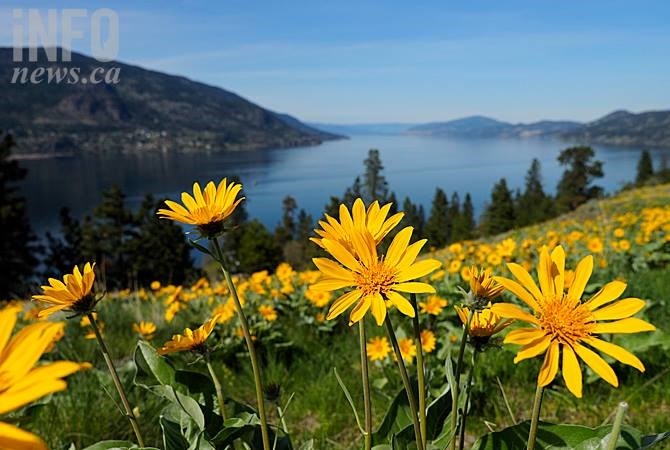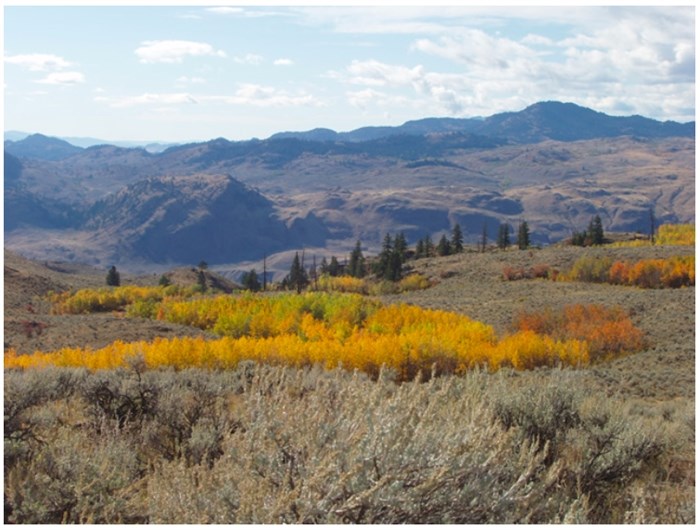
Okanagan sunflowers on Knox Mountain in Kelowna.
(ADAM PROSKIW / iNFOnews.ca)
September 25, 2023 - 7:00 AM
The Okanagan valley is one of the most biodiverse and unique landscapes in Canada but it also one of the most endangered.
The Okanagan combines desert-like grasslands bordering rich marshes and woodland. Encompassing that are imposing hillsides and vast ponderosa pine forests.
It is also home to an impressive and diverse selection of animal and plant species. For example, roughly 190 species of birds breed in the South Okanagan which makes up for half of the Canadian total.
According to the BC Ministry of Environment website, the dry grasslands and open pine forests of the South Okanagan are one of the four most endangered ecosystems in Canada.
“The South Okanagan Valley is a special place in Canada. Its hot, dry summers, mild winters, beautiful lakes and bountiful agricultural lands make it an ideal place for human settlement,” it states on the website. “These characteristics have shaped an ecosystem unique in the nation, an ecosystem now threatened by the human settlement it attracts.”
Adam Ford, a Professor of Biodiversity at UBCO, said that the meeting of semi-arid grasslands, deserts, alpine areas and deep winter snow is what makes the Okanagan so special.
“(Those) extremes provide this part of the world with an incredible structure of changes in temperature and moisture that really give the biodiversity that richness that we've come to celebrate,” Ford said. “There are also the lakes and there's salmon that swim upstream into Osoyoos and the Okanagan, and that's a kind of a unique picture, isn't it? To think of salmon swimming alongside cactuses and rattlesnakes. I think that's an incredible part of this part of the world.”
The rich geological makeup of the region also attracts fruit production, which can have an unfortunate negative impact on the environment, Ford said.
“There's some of the most expensive or most valuable agricultural land in Canada in the Okanagan because you can grow these incredible fruit crops and vineyards and that's not something that happens in very many places in this country,” he said. “So, it is a special place for food production. But that food production comes at a cost of the unique habitats that occur at low elevation, including grasslands.”
Okanagan grasslands are home of many at-risk species such as badgers and burrowing owls which, Ford said, are losing the battle to the various agricultural pressures on the land along with urbanization.
However, these are not the only risks to the Okanagan’s precious biodiversity. Logging also poses a serious threat to vital high elevation habitats.
“We know from research on our eagle, deer and other species that high elevation habitats are really important,” Ford said. “That's where the animals really get a lot of their energy to carry them through for the whole year. And those areas have been severely affected by logging.”
When asked what he believes the best method of tackling the Okanagan biodiversity crisis is, Ford said it will require a combination of conservation efforts, sustainable agricultural practices, and a stronger role for Indigenous perspectives on land management.
“I think the policies that see the land as a resource, that want to capitalize or make profit off of everything they can on the landscape is not conducive to biodiversity conservation all the time,” he said. “At some point, there needs to be a voice for the land.”
One solution that has been the object of years of ongoing controversy is the proposed South Okanagan-Similkameen National Park.

A fall photo of the South Kilpoola area, which is within the boundaries of the proposed South Okanagan-Similkameen national park reserve
Image Credit: BC Parks
On the Let’s Talk South Okanagan-Similkameen website, one of the objectives of the park is to protect and conserve one of the most biologically diverse and rare ecosystems in Canada, the Okanagan.
“A new national park reserve will not only renew a nation-to-nation relationship with Indigenous peoples, but it will contribute to a network of protected and conserved areas,” the website states. “These protected areas help safeguard Canada’s biodiversity and provide unprecedented opportunities for Canadians to experience the outdoors and learn about our environment and contribute to sustainable economic development.”
Professor Kai Chan at UBC played an important role on the board of the Canadian Parks and Wilderness Society, leading a scientist sign-on letter making a case for the importance of the proposed South Okanagan- Similkameen National Park.
Chan told iNFOnews.ca that the park is a necessary development as the current laws are not effective at ensuring well-functioning ecosystems and protecting biodiversity.
“There's a lot at stake and a lot of hopes being pinned on the national park because there aren't other good mechanisms,” he said. “SARA, the Species at Risk Act is woefully under equipped for that purpose and the British Columbia is one of two provinces that lacks a law to protect endangered species. So, there's just like this big void of legislation and a lot being therefore loaded onto the national park.”
However, the proposal received considerable push back, much of which, Chan said, came from stakeholders and outdoor recreation enthusiasts who like to ride dirt bikes, ATVs and other vehicles.
Doreen Olson, co-ordinator of the South Okanagan Similkameen National Park Network, told iNFOnews.ca that push back has come from other several avenues as well.
One of the main protesting groups are cattle ranchers that currently use the land for grazing. Olson explained that ranchers fear that they will not be able to continue grazing despite Parks Canada’s reassurances that they will.
Olson said a National Park would mean more management and surveillance of the area, a fact that has made some rural residents uncomfortable.
“There'd be more eyes out there watching what's going on,” she said. “So, I think that's a fear for some people that they can't do some of the things that they might be doing there. You know, the Freedom Group, they can't be free to do whatever they want anymore.”
Despite concerns, the park may be one of the only viable solutions to protect habitat and biodiversity in the Okanagan. Currently, Olson said, the Okanagan has more endangered species that anywhere else in British Columbia.
“(The Okanagan is) a very narrow corridor. So that makes it all the more rare and it also makes it important to keep open for migration. With climate change happening, we're seeing species come through that don't normally come up this far north in their migration,” Olson said. “We're seeing that development in the valley bottom is taking away this precious corridor.”
Olson explained that the South Okanagan-Similkameen National Park would protect the wildest parts of that important corridor, therefore protecting countless migrating species.
Since she moved to the region in 1994, Olson has seen the landscape change considerably with agriculture and urbanization. Without the protection of a National Park, she said, development will continue, and the natural landscape will be lost forever.
“It's a very special ecosystem. It's just something that you don't find many places,” she said. “The climate is great, although we're seeing lots of changes. The bunch grasses that we have, the plants that we have, those beautiful arrowleaf balsamroot that come in the spring, they'll be gone.”
“You know, it's very unusual, you have to be told about this ecosystem to really appreciate it. It hasn’t got those great big mountains and awe inspiring snow caps and blue streams…It's something that…in order to appreciate it, you almost have to be educated on what it is,” she said. “So, I think Parks Canada will do a tremendous job along with the First Nations in explaining to people what makes this area so special.”
To contact a reporter for this story, email Georgina Whitehouse or call 250-864-7494 or email the editor. You can also submit photos, videos or news tips to the newsroom and be entered to win a monthly prize draw.
We welcome your comments and opinions on our stories but play nice. We won't censor or delete comments unless they contain off-topic statements or links, unnecessary vulgarity, false facts, spam or obviously fake profiles. If you have any concerns about what you see in comments, email the editor in the link above. SUBSCRIBE to our awesome newsletter here.
News from © iNFOnews, 2023